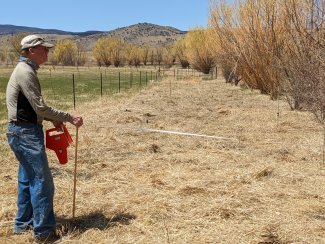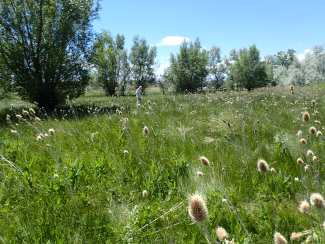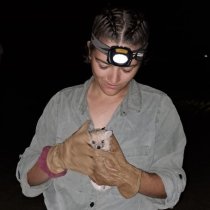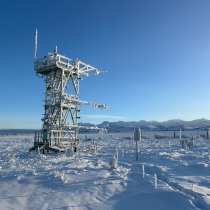Case Study
AGU-TEX Project Update: Supporting Wildland Restoration in Colorado
August 3, 2022
Restoration groups put a lot of sweat and hard work into restoring natural landscapes, including removing invasive plants and (re)planting native species. But how do we know if these efforts are paying off in the long term? Janelle Hakala, a NEON instrument technician and a NEON-TEX Community Science Fellow, worked with Wildlands Restoration Volunteers in Colorado to develop a long-term monitoring plan modeled on the NEON plant protocols.
Monitoring the Impact of Wildland Restoration
Wildlands Restoration Volunteers (WRV) is a Colorado nonprofit that organizes thousands of volunteers to complete more than 150 conservation projects each year. They have been working since 1999 to restore native habitat across the state, including plains, wetlands, and alpine ecosystems. Janelle connected with the group as part of her American Geophysical Union (AGU) Thriving Earth Exchange (TEX) fellowship. AGU's TEX program aims to connect community groups with researchers to sponsor community-led projects around natural resource management, climate change, and response to natural hazards.
One current project in progress is a large wetland restoration project near Boulder. Volunteers are working to convert farmland and wetlands impacted by invasive species back into wetland dominated by historically present species that are adapted for climate change. The goal is to restore the wetland to something closer to its historical state. Janelle connected with WRV during her initial outreach to community-based organizations as she was planning her TEX project. Long-term monitoring came up as a missing component of their program. Janelle says, "They do a lot of restoration projects, but they didn't have a good way of assessing their restoration efforts. They wanted to establish protocols for monitoring changes in vegetation over time. So that's where I thought NEON could come in."

Community project leader Tim Seastedt measuring plot lines during the plot establishment phase of the project. Photo credit: Janelle Hakala.
The NEON vegetation protocols—including plant diversity and phenology—turned out to be a good fit for WRVs monitoring needs. Janelle provided the NEON protocols and ongoing guidance to help them adapt them for the specific needs of the site. The protocols are easy for volunteers to understand and follow and provide a consistent and scientifically valid method for monitoring changes in plant community composition and diversity at their sites. The resulting data will help WRV assess the long-term impact and sustainability of their conservation efforts as well as establish a standardized method for data collection to compare their data to other sites.

Project scientist Alan Carpenter performing data collection/vegetation monitoring at the site. Photo credit: Tim Seastedt.
Reflecting on the TEX Experience
Janelle Hakala joined NEON in 2020 as a field ecologist on the instrumentation team. She now works in the NEON Calibration and Validation Lab ensuring data accuracy and consistency for NEON instruments. Her educational background is in atmospheric science.
What did you hope to gain from participating in the TEX Community Science Fellowship program? Were your personal needs met through the program?
I really wanted the opportunity to do outreach events again. I love working with people and seeing the end product of our work. I did many outreach events throughout college, so getting into that again was great. When I first started with NEON, I was working with data collection, which is awesome. But you don't really see where the data is going or how it could be helping end users. I wanted to see how NEON could interact and connect with different communities and get a greater understanding of what these communities needed.
What skills, lessons or approaches from this experience have (or will) you apply professionally and academically beyond this program?
For me, it was really about networking and reaching out to so many communities. Building those networking skills was a big plus coming out of this. I also developed more leadership and facilitation skills when helping put the project team together and seeing it through.
Did the program help build capacity for local engagement within your Domain?
I think it was extremely helpful in this regard. In the initial stages, it was all about reaching out to many different communities. While looking for the WRV project, I connected with other groups that had different kinds of questions and needs. For some of them, I was able to put them in contact with other NEON scientists. Other connections might be future TEX projects or just good outreach events for NEON in general. And now, a lot more people know about the NEON program and what we offer.

Youth planting event at the site. Photo credit: Wildlands Restoration Volunteers.
In what ways did your project prioritize and support local community needs?
For TEX, the number one goal is to make sure you help the community and understand their needs. The NEON protocols are a great starting point to guide monitoring efforts for these local groups. But ultimately, it was in the hands of the community to adapt them and see how they worked for their specific field site. I think the NEON framework was a good starting point, but application was ultimately driven by the community.
What were or will be the outcomes of your project? What are your hopes for the community/project you matched with?
The main outcomes of the project were establishing the vegetation plots and setting the community up to successfully capture the data within their group. Really though, I think this was just the beginning of the project. It was neat seeing this project go from nothing—they had no way of monitoring changes at their sites—to having a whole setup for ongoing monitoring and assessment. I would hope to see more volunteers getting involved with the protocols and see the data collection continue for years to come. Perhaps eventually more plots could be set up at some of their other field locations.
Coming out of the program, what are your reflections on community science more broadly?
I'm seeing that there are actually many communities out there who want to interact with scientists and work on projects. I think that science just needs to be more available to everyone, including groups like this and underserved groups. It was valuable getting the perspectives of the people I got to work with. I hope to see a lot more connections between scientists and local community groups in the future.



